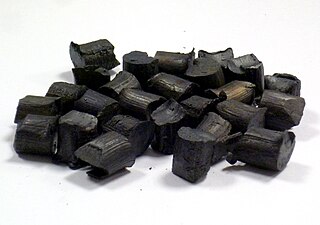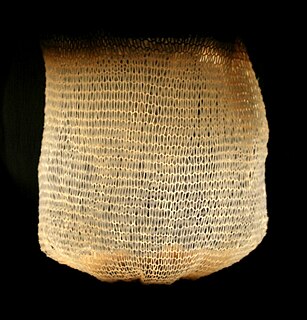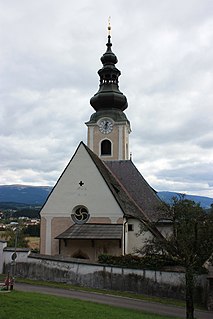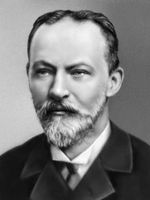
Lutetium is a chemical element with the symbol Lu and atomic number 71. It is a silvery white metal, which resists corrosion in dry air, but not in moist air. Lutetium is the last element in the lanthanide series, and it is traditionally counted among the rare earths. Lutetium is sometimes considered the first element of the 6th-period transition metals, although lanthanum is more often considered as such.

Mischmetal (from German: Mischmetall – "mixed metal") is an alloy of rare-earth elements. It is also called cerium mischmetal, or rare-earth mischmetal. A typical composition includes approximately 55% cerium, 25% lanthanum, and 15-18% neodymium with other rare earth metals following. Its most common use is in the pyrophoric ferrocerium "flint" ignition device of many lighters and torches, although an alloy of only rare-earth elements would be too soft to give good sparks. For this purpose, it is blended with iron oxide and magnesium oxide to form a harder material known as ferrocerium. In chemical formulae it is commonly abbreviated as Mm, e.g. MmNi5.

An incandescent gas mantle, gas mantle or Welsbach mantle is a device for generating bright white light when heated by a flame. The name refers to its original heat source in gas lights, which filled the streets of Europe and North America in the late 19th century, mantle referring to the way it is hung above the flame. Today it is still used in portable camping lanterns, pressure lanterns and some oil lamps.

Didymium is a mixture of the elements praseodymium and neodymium. It is used in safety glasses for glassblowing and blacksmithing, especially with a gas (propane)-powered forge, where it provides a filter that selectively blocks the yellowish light at 589 nm emitted by the hot sodium in the glass, without having a detrimental effect on general vision, unlike dark welder's glasses. The strong infrared light emitted by the superheated forge gases and insulation lining the forge walls is also blocked thereby saving the crafters' eyes from serious cumulative damage such as glassblower's cataract. The usefulness of didymium glass for eye protection of this sort was discovered by Sir William Crookes.

Ferrocerium is a synthetic pyrophoric alloy that produces hot sparks that can reach temperatures of 3,000 °C (5,430 °F) when rapidly oxidized by the process of striking the rod, thereby fragmenting it and exposing those fragments to the oxygen in the air. This property allows it to have many commercial applications, such as the ignition source for lighters, strikers for gas welding and cutting torches, deoxidization in metallurgy, and ferrocerium rods. Due to ferrocerium's ability to ignite in adverse conditions, rods of ferrocerium are commonly used as an emergency combustion device in survival kits.
Auer is a surname. Notable people with the surname include:

Althofen is a town in the district of Sankt Veit an der Glan in the Austrian state of Carinthia.

Mölbling is a municipality on the Gurk River in the district of Sankt Veit an der Glan in the Austrian state of Carinthia.

Bohuslav Brauner was a Czech chemist.

Karl Kordesch was an Austrian chemist and inventor, most notable for jointly inventing the alkaline battery.
Auerlite is a rare North Carolina mineral variety, remarkably rich in thoria, named after Carl Auer von Welsbach, the inventor of the Welsbach incandescent gas mantle. It is considered to be a phosphorus bearing variety of thorite.

Salvum fac populum tuum, WAB 40, is a motet composed by Anton Bruckner in 1884.
Welsbach seeding is a patented climate engineering method, involving seeding the stratosphere with small metal oxide particles. The purpose of the Welsbach seeding would be to "(reduce) atmospheric warming due to the greenhouse effect resulting from a greenhouse gases layer", by converting radiative energy at near-infrared wavelengths into radiation at far-infrared wavelengths, permitting some of the converted radiation to escape into space, thus cooling the atmosphere. The seeding as described would be performed by airplanes at altitudes between 7 and 13 kilometres.
Welsbach is a surname. Notable people with the surname include:
Articles on Welsbach include:

Erhard Auer was a Bavarian politician, member of the state parliament, first Minister of the Interior of the Free State of Bavaria and SPD -Partivorsitzender in Bavaria.
This page is based on this
Wikipedia article Text is available under the
CC BY-SA 4.0 license; additional terms may apply.
Images, videos and audio are available under their respective licenses.











